MIBS 2017: Furuno standalone 1815 radar, DFF-3D multimodal sonar & more
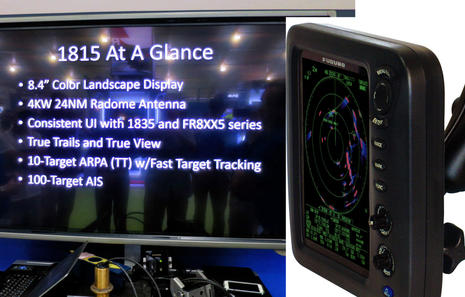 While Furuno USA had a lot to show off at the Miami Boat Show, let’s start with the new 1815 standalone radar. Recent Panbo entries about Raymarine’s sleek new Axiom Series multifunction displays and Navico’s ambitious systems integration strategy drew some keep-it-simple skeptics. But it is still possible to find single function marine electronics if that’s your preference, and the 1815 may be an excellent small radar choice packing a whole lot of performance for the price…
While Furuno USA had a lot to show off at the Miami Boat Show, let’s start with the new 1815 standalone radar. Recent Panbo entries about Raymarine’s sleek new Axiom Series multifunction displays and Navico’s ambitious systems integration strategy drew some keep-it-simple skeptics. But it is still possible to find single function marine electronics if that’s your preference, and the 1815 may be an excellent small radar choice packing a whole lot of performance for the price…
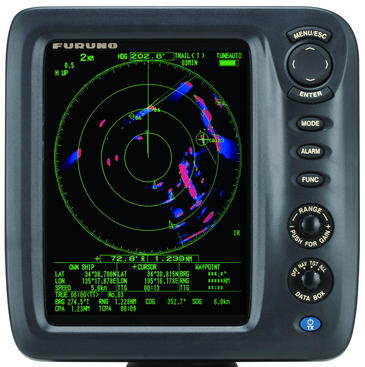 The Furuno 1815 radar retailing for $2,500 includes the 8.4-inch color portrait display and control head seen above, along with a 19-inch 4kW radome. And those bright blue “True Trails” seen on the screen are a very useful feature not available on most recreational radars at any price. True echo trails, as opposed to the much more commonly seen relative trails, means that the trails show actual target motion regardless of your boat’s motion. The direction of the true trail indicates the target vessel’s heading over the ground while its length suggests its speed.
The Furuno 1815 radar retailing for $2,500 includes the 8.4-inch color portrait display and control head seen above, along with a 19-inch 4kW radome. And those bright blue “True Trails” seen on the screen are a very useful feature not available on most recreational radars at any price. True echo trails, as opposed to the much more commonly seen relative trails, means that the trails show actual target motion regardless of your boat’s motion. The direction of the true trail indicates the target vessel’s heading over the ground while its length suggests its speed.
Incidentally, some other recreational radars can show true trails but usually as only one aspect of a True Motion view in which your vessel moves across the screen instead of the targets, trails, etc. moving along with your vessel (more detailed discussion here). Some users are confused by true motion, and, to the best of my knowledge, only Furuno offers true trails regardless of viewing mode. Moreover, the 1815 also offers an unusual True View mode, which is a lot like the simple and popular Head Up mode, except that all the target imaging responds to your boat’s actual heading instead of just where the bow is pointed.
 Both of these 1815 screens show True Trails at work (in Head Up mode) as well as the 1815’s ability to plot AIS targets and to track its own targets. I was intrigued to see the latter described in Miami as “10-target ARPA (TT) with Fast Target Tracking”, because FTT is also what Furuno calls the phenomenal ARPA tracking I’ve seen from their DRS4D-NXT radome.
Both of these 1815 screens show True Trails at work (in Head Up mode) as well as the 1815’s ability to plot AIS targets and to track its own targets. I was intrigued to see the latter described in Miami as “10-target ARPA (TT) with Fast Target Tracking”, because FTT is also what Furuno calls the phenomenal ARPA tracking I’ve seen from their DRS4D-NXT radome.
For instance, in my experience Fast Target Tracking would mean that target #3 on the left screen above was intelligently and automatically selected, because it’s moving my way, and, moreover, that its true heading and speed were calculated very quickly and accurately. With the NXT, I also see very fast results for targets I select manually, which I’m usually doing with a fingertip on the test NavNet TZT2 12-inch MFD, and then a similar tap pops up the target’s heading and speed info.
On the 1815 display that sort of easy finger work will have to be done with the cursor control and Enter button, and while the NXT radar can handle 100 automatic and manual targets at once, the 1815 is limited to 10. And it turns out there’s more Fast Target Tracking limitation in the 1815 than that.
 As you can see in the 1815 manual inset above, automatic target acquisition is limited to a fixed 90° guard zone two miles ahead of your vessel. That’s like the first Furuno NavNet ARPA I experienced, except that you could customize the zone, and the amazing NXT acquires whatever targets it thinks are important anywhere around you, no zone needed. Tentative 1815 owners should understand these limitations, but complaints aren’t easily justified. I’ll bet that few readers have any sort of automatic radar plotting aid (ARPA) unless they already own a fairly modern Furuno.
As you can see in the 1815 manual inset above, automatic target acquisition is limited to a fixed 90° guard zone two miles ahead of your vessel. That’s like the first Furuno NavNet ARPA I experienced, except that you could customize the zone, and the amazing NXT acquires whatever targets it thinks are important anywhere around you, no zone needed. Tentative 1815 owners should understand these limitations, but complaints aren’t easily justified. I’ll bet that few readers have any sort of automatic radar plotting aid (ARPA) unless they already own a fairly modern Furuno.
Actually, the ARPA situation is rather remarkable given how competitive marine electronics is. For years Furuno has been the only manufacturer I know of offering it in recreational radars, even though this valuable feature seems high on the list of every radar product manager I know. But recently Furuno has apparently improved the speed and accuracy of its MARPA and still unmatched ARPA with Fast Target Tracking algorithms, and absolutely supercharged them with the Doppler assistance available in the solid-state NXT.
So even the 1815’s limited ARPA/MARPA FTT — maximum five targets each — is impressive. But tentative owners should also realize that getting the 1815’s advanced features requires NMEA 0183 interfacing with Heading, GPS, and AIS sources, and a plotter data interface can be very useful, too (chart overlay is not possible, but you can at least have a shared go-to waypoint that helps orient your radar and plotter views). In other words, a full-featured 1815 installation won’t be completely standalone, as suggested in diagram above. Also, it’s almost invariably smart shopping to study the product manual as well as the brochure.
X-Class 12 & 25 kW
 In Miami Furuno also added 12 and 25 kW versions to its X-Class family of NavNet open array radars. They’re modular — so, for instance, that original $5,395 DRS6AX with a 3.5-foot antenna could be alternately rigged with 4- or 6-footers for a maximum retail total of $6,240 — and you have to delve into both TZtouch and TZtouch2 operator manuals to see some of the possible radar display features (which differ between the two MFD series).
In Miami Furuno also added 12 and 25 kW versions to its X-Class family of NavNet open array radars. They’re modular — so, for instance, that original $5,395 DRS6AX with a 3.5-foot antenna could be alternately rigged with 4- or 6-footers for a maximum retail total of $6,240 — and you have to delve into both TZtouch and TZtouch2 operator manuals to see some of the possible radar display features (which differ between the two MFD series).
Actually, right now only the TZT2 software 4.01 literature will tell you about that Echo Trail, and Average functions are now available (which Fred Khedouri missed in his early TZT2 review). Also, both TZT and TZT2 support True Trails, but I’m waiting on the exact parameters of X-Class automatic and manual Fast Target Tracking (hopefully just until tomorrow).
 A lot of features like automatic and effective bird mode are highlighted on the dedicated X-Class radar site and in the X-Class video. Adding to the high performance image roster is the Miami presentation screen above, which seems to indicate very effective auto rain filtering. It’s interesting that Furuno, which has already developed commercial FAR-3000 solid-state S-band radar plus the remarkable NXT radome, is so far sticking with magnetron technology for its high-end recreational X-band open arrays.
A lot of features like automatic and effective bird mode are highlighted on the dedicated X-Class radar site and in the X-Class video. Adding to the high performance image roster is the Miami presentation screen above, which seems to indicate very effective auto rain filtering. It’s interesting that Furuno, which has already developed commercial FAR-3000 solid-state S-band radar plus the remarkable NXT radome, is so far sticking with magnetron technology for its high-end recreational X-band open arrays.
Yamaha engine integration
 In Miami we also got a peek at the Yamaha gauge and control integration that will soon come as a software update to TZtouch2 displays. It’s not quite the “first” Furuno expected, but it certainly looks like a complete integration close in style and function to Yamaha’s own Helm Master display, and it can also emulate the Command Link LCD and Digital interfaces. All that’s needed is a NMEA 2000 “interface unit” which is actually a new Yamaha gateway that has not been released yet (more info coming).
In Miami we also got a peek at the Yamaha gauge and control integration that will soon come as a software update to TZtouch2 displays. It’s not quite the “first” Furuno expected, but it certainly looks like a complete integration close in style and function to Yamaha’s own Helm Master display, and it can also emulate the Command Link LCD and Digital interfaces. All that’s needed is a NMEA 2000 “interface unit” which is actually a new Yamaha gateway that has not been released yet (more info coming).
Furuno’s Yamaha integration is not diminished by a similar Simrad announcement during the Miami show nor the fact that Yamaha simultaneously chose the Garmin 7-inch MFD as its new full–featured CL7 Command Link Plus and Helm Master display. (Garmin has not said if the Yamaha integration will also come to their regular MFDs, but that seems likely (and would be a lot like the Navico/Mercury VesselView relationship).)
DFF-3D multi modal sonar
 Last, but certainly not least, is the new DFF-3D multi-beam black box sonar for TZT and TZT2. Based on experience with their commercial WASSP muti-beam technology, Furuno developed four different modes for viewing the DFF-3D output, all of which can be used simultaneously.
Last, but certainly not least, is the new DFF-3D multi-beam black box sonar for TZT and TZT2. Based on experience with their commercial WASSP muti-beam technology, Furuno developed four different modes for viewing the DFF-3D output, all of which can be used simultaneously.
The side-scanned structure imagery visible on the background screen above is now familiar to many boaters because it’s available from the other three big brands. And the 3D view at lower right — in which the side scan info becomes a skin over a 3D model of the bottom with separate targets, often fish, highlighted in 3D underwater space — is likewise becoming familiar (and popular). But that triple beam version of a traditional fishfinder view and what they call the cross section view are new to me, and both are potentially useful.
 But what really seems different compared to the competition is the DFF-3D’s higher power and lower frequency, a combination that seems to fit with Furuno’s brawnier, bigger boat style. Note, for instance, that the 3D example Eric Kunz is discussing above shows bottom detail 600 feet deep in a swath about 800 feet wide. In fact, this sonar only sweeps 120 degrees port and starboard, not 180, and that makes sense away from shore where there’s not much to see that’s sideways and nearby.
But what really seems different compared to the competition is the DFF-3D’s higher power and lower frequency, a combination that seems to fit with Furuno’s brawnier, bigger boat style. Note, for instance, that the 3D example Eric Kunz is discussing above shows bottom detail 600 feet deep in a swath about 800 feet wide. In fact, this sonar only sweeps 120 degrees port and starboard, not 180, and that makes sense away from shore where there’s not much to see that’s sideways and nearby.
The DFF-3D retails at $2,095 and that’s without one of the necessary multibeam transducers developed with Airmar. The closeup view of the transom mount model below says a lot, though perhaps mainly that this multimodal sonar is unlike anything else I know of in the recreational world. Furuno did not respond quickly to the rapid evolution of side scanning and 3D for fresh water and coastal fishing, but now they have, in their own way.



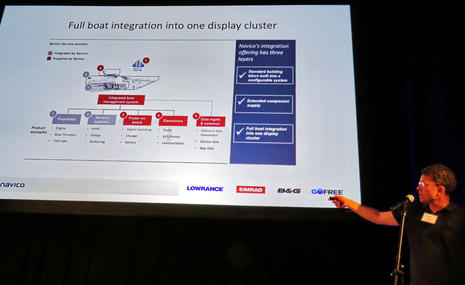
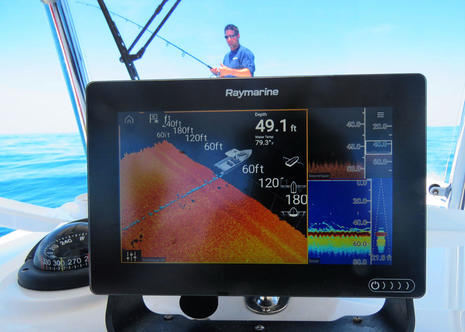

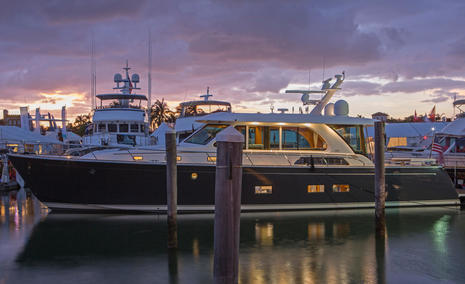








Detail on Furuno X-Class radar ARPA and MARPA with Fast Target Tracking: They can automatically acquire up to 30 targets with a guard zone that can be variably set from 0.1 to 24 miles, or some of 30 maximum can be acquired anywhere manually.
Meanwhile, with Doppler assistance the NXT radome can get 40 ARPA targets anywhere within 3 NM, another 30 ARPA within a custom guard zone out to 24nm, plus 30 manual anywhere for 100 total.
The “Triple Beam” view and the “Cross-Section” view (called “Swath” or “Vertical” on the Wassp) are really the ones who are in fact useful.
On our 160 kHz Wassp we basically NEVER use the simulated Sidescan-view or the integrated 3D environment that you can pan and zoom around in. They are more or less useless when it comes to real-world usage.
Worth to note is that the Triple Beams have selectable Beam Width and Angle of Attack so you can freely choose from how many elements in the Swath each of the three echograms are generated from. Very useful.
In the commercial market the Wassp will probably be outcompeted by the new ATEC400 and the SeaPiX multibeam systems (atleast in Europe) so it is a logical step for Furuno to move downwards in the market segments rather than upwards.
Airmar has not yet released any information from their part on this “so-called” B54/B-54 transducer model.
However from the images from the presentations and also the operator/installation manual one can clearly conclude that there are present 8-wires going into the transducer elements (when motion and temp sensor wiring is deducted).
This means the transducer itself consists of 4 individual elements and from the videopresentation and brochures one can clearly distinguish 32 beams forming the bottom echo edges/jaggies in the trapezoid.
So they are beamforming 8 electronic beams from each physical transducer element. Very similar to the Wassp which has 112 or 224 beams which are beamformed from something like 32 or 64 individual elements in the transducer array.
Our old WMB-160F has an old type molded multicable going from the ducer directly into the beamformer PC but the newer S3/F3 use standard RJ45/Ethernet cabling and there are 8 connectors in total in the WDRX. I guess they run analog signals even though it’s ethernet-cabling.
So since there is 8 wires (=4 pairs) in each cable it will mean that the most individual number of elements present in the Wassp sounder is 32.
Either both the old and the new Wassp have the same number of ducers and they just improved the beamforming (electronically giving them more beams) or the old one actually only had 16 transducer elements. I do not know which it is but I am guessing that there actually where 32 in the old one also.
So in all essence: the DFF-3D has 8 times LESS resolution across the Swath compared to the WASSP. Still impressive though!
Does the DFF3D offer backward compatibility to NN3D (non-touch) systems? I have a black ox NN3D system, with MaxSea Professional running on an interfaced PC, with a DFF3 fishfinder. With MaxSea software, I am able to create and view, in 3D, bathymetric data, which NN3D cannot do. Although I doubt that the NN3D system will ever be updated to accommodate the new functionality of DFF3D, perhaps MaxSea will be? Anyone know or have any insights?
From what I have understood from my local Furuno dealership there will never be any form of possibility to do permanent bottom mapping with the DFF-3D, either with connection to MaxSea or within the TZT units. This is because it would cannibalize of the sales of the Wassp system. All the 3D data that is generated in the 3D view are only “temporary” and is thrown away after a certain amount of time.
However I find it highly likely that they will incorporate a possibility to watch the live feed via NavNet from the DFF-3D inside MaxSea/TimeZero since they have done so with the FCV-1150 and even the FCV-1900 echosounders.
It’s really a shame since if they would allow bathymetric profiling with the DFF-3D inside TimeZero it would be a super intresting alternative for those where a full Wassp system is clearly out of reach, be it moneywise or spacewise.
Furuno JP have done the exact same thing when it comes to radars. Before the release of the FAR-3000 radar the price for a FAR-2117-X-BB was approx 9,000-10,000 Euros or similar. When they realized no one was buying the 3000 because the 2117 was so highly acclaimed AND competetively priced they bumped the price of the 2117 up to the 13,000-14,000 Euro range.
THEN they released the FAR-1500 in both IMO and non-IMO versions at a competetive price range, but they where smart enough to lower the resolution of the PPI to 1024×768 instead of 1280×1024 for the 2117 (or the FullHD of the 3000) so IMO would not WheelMark-approve the radar for larger vessels or bigger screens. The FAR-1500 with FullHD support would be such a killer radar that all competetion could just file for bankrupcy… So it’s a big shame…
I guess the Furuno sales department in Japan feels they are really really smart – only problem is their move will just make everyone angry and drive sales like crazy for JRC and their very low priced ConstaView IMO approved radars.
So my theory is no bathymetric function for the DFF-3D – I hope I am wrong…
Rick,
I asked MaxSea about the possibility of recording multibeam data with the DFF-3D in much the same way the single beam systems work for their PBG module, and here was the response:
“Thank you for contacting us. Indeed, we are currently developing the compatibility of TZ Professional with the new Furuno’s DFF-3D. This solution should be available by 2018, but we can’t guarantee a specific date.”
So it looks like I’ll be upgrading my boat sometime after the functionality comes up. I don’t really have much use for the DFF-3D until I can record bottom structure with it.
Kevin
Thanks for your insights PaRaDoX. I have a full Furuno system (TZProfv3, TZT14, DFF1-UHD etc) and have been frustrated trying to get access to all the data generated to manipulate, validate and integrate it. But I do like the hardware. So I am looking hard at other systems where I own the data.
Kevin,
That is the direct opposite of what my Furuno dealership is telling me, but if the guys at Informatique is publicly stating they’re working on it, they would of course know better… But perhaps they missunderstood your mail and what they ARE working on are an implementation of WATCHING the DFF-3D data inside MaxSea/TZ and not a Multibeam-PBG solution.
But sounds very interesting. I hope they are working on it with full PBG support, that would be like a Wassp-Mini for smaller boats that cannot afford the Wassp.
The FEC boardmembers in Japan really need to sort their fear of cannibalization and invite some Silicon Valley folks to preach Disruption theory for them…
It does indeed look like TimeZero Professional v3.3 will ve able to record bathymetry data from the DFF-3D. There are a few Facebook posts starting to go around from Furuno Fishing Fanatics and TimeZero:
https://www.facebook.com/TIMEZERObyMaxSea/posts/10155109829188947:0
From TZ: TZ Professional connected to the Furuno DFF3D can record 50 depth points per second!